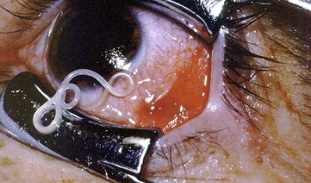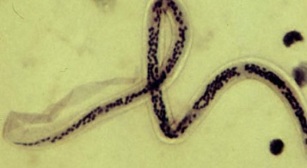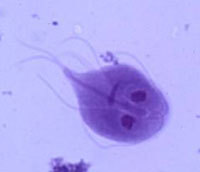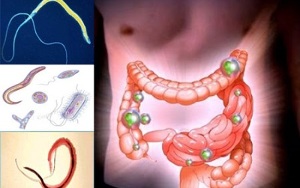
Parasites in biology are organisms that carry out their vital activities at the expense of another organism of a different biological species.
This vital activity of the parasite does not bring any benefits to the host organism, and at best, the interaction does not lead to the development of adverse effects.
In the worst case, the parasite causes the death of the host. In this case, either the parasite escapes to the external environment, or joint death.
Human parasitic diseases have been known practically since the earliest times of human existence. This fact was established directly during the observation of the behavior of human ancestors - apes. Parasites living in wool are detected by monkeys and removed from each other. This process has a very important feature of social interaction.
Human intolerance to acne and pores on the skin begins in the early days of human existence. Some insect parasites in the tropics can place their larvae on the skin. This causes a reflex call to squeeze them out of the skin.
Various worms that affect the eyes, skin, and gastrointestinal tract have been described by ancient scientists. With the development of microscopy and its application to medical practice in the 18th and 19th centuries, scientists have identified the causes of parasites and ways of infection that can cause specific diseases in humans.
- The beginning of the 20th century and the discovery of antiparasitic substances allowed mankind to cope with most parasitic diseases.
Thus, mankind has been closely associated with various parasites throughout history. However, modern medical science allows to diagnose the whole spectrum of parasites quickly and fairly accurately, which allows doctors to treat such diseases as soon as possible and with minimal risks for patients.
The general practitioner will help determine the parasites, symptoms and treatment in the human body. Sometimes a narrower specialized infectious disease specialists - parasitologists can be involved.
What are parasitic diseases?

Parasitic diseases are nosologies that occur after the introduction (occupation) of biological substances into the body. The latter belong to the group of human parasites. The symptomatology of such diseases is extremely diverse and depends on the exact rooting agent and the vital activity in the body.
Due to the effects of parasites on the human body, they are generally divided into the following groups:
- Exoparasites affecting human skin and hair.
- Toxic effects of parasite waste products on the body.
- Parasite damage the mucous membranes of the gastrointestinal tract and lungs.
- Formation of cysts and cysts in human organs. The increase in the size of such cysts and cysts causes signs of organ compression.
- Violation of the normal passage of food through the gastrointestinal tract. This can lead to intestinal intussusception (mostly in children) or the development of intestinal obstruction.
- Parasites living inside a person can cause sensitivity and non-specific allergic reactions.
- Microparasites can disrupt the function of blood cells, causing fever and intoxication.
- The effects of some types of parasites on the body not only cause severe symptoms, but can also lead to organ failure or death.
Such various adverse effects from parasites in the body are due to different biological species that enter the human body. However, such a biological diversity of parasites living in the human body has allowed doctors to identify specific symptoms of parasitic diseases.
Parasites living in the human body

The main ways in which humans are infected with parasites depend on the life cycle of the biological organism that causes the parasitic disease.
Doctors describe the ways in which a parasite can infect a person as follows:
- contact path.It is characteristic of exoparasitic insects, as well as some aquatic helminths whose larvae enter under human skin. In this way, both a sick person and contaminated linen, bedding, personal or public hygiene items, etc. You can be infected. Of infection
- fecal-oral route. Pathogenic cysts mainly occur when food comes in contact with contaminated animal feces. Autoinvasion can also be observed - infection of a person if the rules of personal hygiene are not followed, and so on.
- Pollution.The pathogen enters the bloodstream when an infected insect is crushed.
- Transmissible infection.The parasite enters the bloodstream when bitten by an infected insect. Often this route of transmission is characteristic of the simplest parasites, such as malaria.
- Sexually transmitted infection.It is characteristic of both venereal diseases caused by parasites, as well as some helminths that can affect the human urinary and genital organs.
Protozoa, helminths (round and flatworms), insects and some species of fungi are among the causes of parasitic diseases.
The formation of humans by these species depends on the geographical and climatic zone. Therefore, the medicine of each country keeps its own records and a list of specific parasites.
Biological organisms that enter the human body have been studied in detail by both medical biologists and physicians, which has made it possible to accurately classify all biological species that can cause parasitic diseases:
- The simplest organisms (amebiasis, balantidiyaz, babeoz, Chagas disease, leishmaniasis, malaria, lard, trypanosomiasis, toxoplasmosis, trichomoniasis).
- Helminths. Sometimes the term worms is used (ascariasis, dichroceliosis, diphyllobotriasis, drinkuliosis, clonorchia, opisthorchiasis, strongiloidosis, teniasis, fascioliasis, schistosomiasis, enterobiosis, echinococcosis).
- Exoparasites (lice (groin, head, clothes), demodicosis, fleas, insects, itching).
Symptoms of parasites in the human body

Unfortunately, there are no clear signs of parasites in the human body and no signs of a parasitic infection. This leads to the need for special tests for an accurate diagnosis, for example, helminthiasis.
On the other hand, almost all exoinfections are diagnosed very simply - based on the clinical picture and the specific type of insect on the skin.
In general, all the symptoms of parasitic diseases can be grouped into the following groups:
- Itching and discomfort of the skin caused by external hair and skin parasites (fleas, lice, etc. ). Acne and itchy skin rashes are often associated with a disease such as demodicosis (a specific type of tick).
- Pain in various parts of the body as a result of the parasite entering the skin and muscles (some aquatic worms).
- Pain in the eyes, blurred vision.
- Pain in the lungs, coughing up sputum (this condition is characterized by migration of ascaris larvae in the lungs, as well as echinococcal cysts of the lungs).
- Nausea, vomiting, and diarrhea are common symptoms of most helminths parasitizing the digestive system.
- Jaundice, diseases of the liver and bile ducts, liver failure. These symptoms are caused by helminths that affect the liver and bile ducts, as well as malaria at the highest level of the disease.
- Stomach pain.
- Intestinal obstruction due to the closure of the intestinal lumen by a large number of roundworms or large worms.
All these signs of the presence of parasites in the human body, in the absence of information for another pathology, should motivate doctors to think about a parasitic human disease and play a key role in diagnostic and laboratory studies.
Diagnosis of parasites in humans
Depending on the type of parasite that invades the human body, this or that research is carried out. If we talk about foreign exoparasites, which are mainly insects, the diagnosis of the disease is generally limited to general examination, along with insect microscopy.
A general examination generally provides an accurate diagnosis and appropriate treatment or cleansing of the scalp or scalp. In the case of demodicosis or pruritus, the diagnosis can be easily made based on the location of the rash and the presence of pruritus.
In this case, microscopic specimens confirm the diagnosis of intradermal parasites.
The main screening test for gastrointestinal parasites (a diagnostic procedure that allows a quick and relatively informative assessment of information about the presence of disease in a large number of people) is fecal analysis.
- With the help of microscopic examination of special feces, the laboratory assistant can detect worm eggs, dead helminths, cyst capsules, etc.
According to the morphology of helminth eggs, you can almost certainly identify the type of worm that parasitizes the body. Sometimes segments of tapeworms are identified macroscopically in the stool. They are then examined under a microscope to determine the appearance of a flatworm parasitizing the gastrointestinal tract.
In some cases, for example, when the diagnosis of parasites in the body is not possible or known by analysis of feces, immunological tests are used. They allow you to assess the presence of antibodies against a particular type of helminth. Unfortunately, due to the special immunological link between the human immune system and the parasite, in some cases the level of antibodies does not reflect the true picture of the disease.
During malaria, a thick drop of blood is tested to detect Plasmodium malaria. Total blood counts, leukocyte levels, and all biochemical parameters of the blood, especially the liver, are also assessed.
Increased blood eosinophils are a frequent sign not only of allergic diseases, but also of helminthic invasions. This is the first "call".
Sometimes helminths in the gastrointestinal tract are a diagnostic finding during contrast radiography, cystoscopy, FGDS, colonoscopy.
How to get rid of parasites in the human body?

Treatment of parasitic infections should be carried out only by a doctor, following certain rules.
In such cases, self-medication and traditional medicine do not improve, and can sometimes be fatal.
It is also important to provide preventive treatment for all family members and relationships.
Human exoparasites parasitizing hairy areas of the body are destroyed with special disinfectants. Generally, a single treatment after a hygienic wash is sufficient to kill exoparasites.
When it comes to skin types of parasites (itching, demodicosis), use special ointments that are insecticides against such organisms.
Antihelminthics are used against helminths, especially round and flatworms, which act in the main lumen of the gastrointestinal tract. Depending on the type of biological helminth, different treatment regimens are used (from one tablet to a number of courses).
In order to recognize the side effects and side effects of drugs in a timely manner, such drugs should be used strictly under the supervision of a physician.
No other treatment, detox program, etc. it cannot cause the parasites in the body to die completely and eventually heal.



























